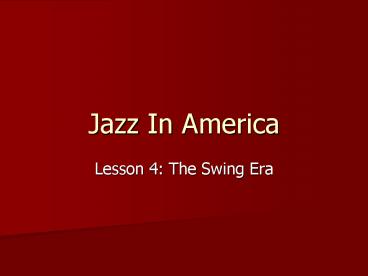Jazz In America - PowerPoint PPT Presentation
1 / 20
Title:
Jazz In America
Description:
Jazz In America Lesson 4: The Swing Era Transition from Dixieland Written Arrangements By the end of the 1920s, jazz was developing in two complimentary directions ... – PowerPoint PPT presentation
Number of Views:818
Avg rating:3.0/5.0
Title: Jazz In America
1
Jazz In America
- Lesson 4 The Swing Era
2
Transition from DixielandWritten Arrangements
- By the end of the 1920s, jazz was developing in
two complimentary directions - Emphasis on soloist
- Emphasis on ensemble
- Collective improv kept the structure simple
- To accommodate more sophisticated music and more
musicians, written arrangements became more common
3
Transition from DixielandWritten Arrangements
- Written arrangements became the product of one
persons mind the arranger - Written arrangements all but eliminated
collective improv, but allowed for individual
soloists to improvise
4
Transition from DixielandEnsemble Size
- Several well-known small ensembles, but the Swing
Era was characterized by the big band - Typical Dixieland group of 5 7 members grew to
15 18 during 1930s 1940s - Allowed for new dimensions to be added to the
music
5
Transition from DixielandEnsemble Size
- Dixieland Band
- 1 Trumpet
- 1 Clarinet
- 1 Trombone
- 1 Bass/Tuba
- 1 Piano/Banjo
- 1 Drum Set / 2 Drummers
- Big Band
- 4 Trumpets
- 5 Saxophones
- 4 Trombones
- 1 Bass
- 1 Piano
- 1 Guitar
- 1 Drum Set
- Anything else the arranger wanted
6
Transition from DixielandNew Breed of Jazz
Musicians
- Many were formally educated
- Many came from brass military bands
- Represented a cross of readers and non-readers
7
Transitions from DixielandMovement of Music
- Jazz started in New Orleans, but moved to Chicago
and then New York - Chicago already had its own style of Dixieland
- NY was the center of the music world
- Recording companies
- Publishing houses
- All fields, all styles
- Music business activities
8
Transition from Dixieland and all that Jazz
- Dates
- 1920-1935 beginning of the big bands
- 1935-1945 the Swing Era
- New song forms
- e.g., AABA, songs were capable of evolution
- Radio
- Spread of radio and recording made it popular
throughout the U.S. - Harmony
- Tunes were capable of greater harmonic
sophistication - Moved from polyphony to homophony
9
Performance PracticesThe Instruments
- The Saxophone Section
- Generally 5 saxophones
- Two Altos
- Two Tenors
- One Baritone
- Usually also played the clarinet
10
Performance PracticesThe Instruments
- The Trumpet Section
- Generally 4 trumpets
- The Trombone Section
- Generally 4 trombones
11
Performance PracticesThe Instruments
- The Rhythm Section
- Generally 4 pieces piano, bass, drums, and guitar
12
Performance PracticesTypical Arrangements
- Example 1
- Melody played by entire band in unison or in
harmony rhythm section provides accompaniment
throughout - Example 2
- Melody and accompaniment parts would often be
played in turn by various sections in the band - Example 3
- Call and response
13
Performance PracticesTypical Arrangements
- Example 4
- After melody is played, jazz improv follows
- Ex. Wrappin It Up, Fletcher Henderson
- Example 5
- Simple musical phrases played over and over
called riffs - Ex. One Oclock Jump, Count Basie
14
Performance PracticesRhythm Section
- Drums
- Played simply, making the beat obvious for
dancers - Swung, emphasizing the second and fourth beet of
each measure - Bass
- Kept time
- Played in either two-beat style or walking bass
style - Outlined the chord progressions
15
Performance PracticesRhythm Section
- Piano
- Played chords either stride style, on every beat,
or on every other beat - Comping was NOT common
- Occasionally played melodies and melodic
embellishments - Guitar
- Played chords, percussively on each beat
16
Performance PracticesDifferences from Dixieland
- More use of written arrangements
- Wider range of compositional styles fewer
ragtime-like tunes - More solo improvisation, less collective
improvisation - More use of string bass, less use of tuba
- More use of guitar, no banjo
- SAXOPHONE is predominant instrument
17
Cultural Implicationsof the Swing Era
- Jazzs most popular period
- Hundreds of professional big bands flourished in
the 1930s early 1940s - After the stock market crash of 1929, swing
helped the country through the Great Depression,
creating escape via swing dancing - Served as a major morale booster in WWII
18
Cultural Implicationsof the Swing Era
- Jazz reached new levels of sophistication in the
Swing Era - Weak economy lead many recording companies into
bankruptcy - Jazz proliferated through the radio
19
Cultural Implicationsof the Swing Era
- There were hundreds of performance venues
- Ballrooms
- Movies
- Hotels
- Record Companies
20
Cultural Implicationsof the Swing Era
- Race Relations
- For the first time, it didnt matter what color
you were, just how well you played - First interracial groups The Benny Goodman Trio,
Quartet, Sextet, and Big Band (1935) - Jazz increased the appreciation of the
achievements of African Americans

